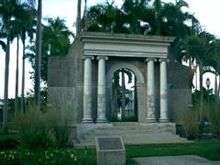University of Puerto Rico at Mayagüez
The University of Puerto Rico, Mayagüez Campus (UPRM) or Recinto Universitario de Mayagüez (RUM) in Spanish (also referred to as Colegio and CAAM in allusion to its former name), is a public land-grant, sea-grant, space-grant university in Mayagüez, Puerto Rico. UPRM is the second-largest university campus of the University of Puerto Rico system. In 2009, the campus population was composed of 12,108 students, 1,924 regular staff members, and 1,037 members of the education staff.[1] In 2013, the student population remained relatively steady at 11,838, but the instructional faculty dropped to 684.[2]
Recinto Universitario de Mayagüez | |
 Official seal of UPRM | |
| Latin: Universitatis Portoricensis Mayagüez | |
| Motto | ¡Antes, Ahora y Siempre...Colegio! |
|---|---|
Motto in English | Before, Now, and Forever...Colegio! |
| Type | Public, land-grant, sea-grant, space-grant |
| Established | September 23, 1911 |
| Endowment | US $256 million |
| Rector | Dr. Agustín Rullán Toro |
Academic staff | 1,026 |
Administrative staff | 1,336 |
| Students | 13,148 |
| Undergraduates | 12,079 |
| Postgraduates | 1,069 |
| Location | , |
| Campus | Urban, 315 acres (1.27 km2) |
| Colors | Green and White |
| Athletics | |
| Nickname | Colegio |
| Affiliations | NASULGC |
| Mascot | Tarzán (male) and Jane (female), both bulldogs |
| Website | www |
UPRM has been accredited by the Middle States Commission on Higher Education (MSCHE) since 1946. Also, the engineering undergraduate program is accredited by the Accreditation Board for Engineering and Technology (ABET), the nursing undergraduate program is accredited by the National League for Nursing (NLN) and the Chemistry Department is recognized by the American Chemical Society (ACS). The College of Business Administration is going through the process of the AACSB accreditation. The Mayagüez campus of the University of Puerto Rico has been a member of Oak Ridge Associated Universities (ORAU) since 1966.
UPRM is comprised by the Colleges of Agricultural Sciences, Arts and Sciences, Business Administration, Engineering, and the Division of Continuing Education and Professional Studies. The College of Agricultural Sciences includes the Agricultural Experiment Station and the Agricultural Extension Service.
History
The University of Puerto Rico was created by an act of the Legislative Assembly on March 12, 1903, emerging as an outgrowth of the Normal School, which had been established three years earlier to train teachers for the Puerto Rican school system. In 1908, the benefits of the Morill-Nelson Act declared applicable to the island, fostered the rapid growth of the university. Eloquent evidence of that growth was the establishment of the College of Liberal Arts at Río Piedras in 1910 and the College of Agriculture at Mayagüez in 1911 as a land-grant university.[3]
The founding of the institution is credited to D.W. May (Director of the Federal Experiment Station), José de Diego and Carmelo Alemar. In 1912 the name of the institution was changed to the College of Agriculture and Mechanic Arts or Colegio de Agricultura y Artes Mecánicas (CAAM).
In 1918, an earthquake and a fire caused significant damage to the institution. The ruins of the entrance of one of the buildings, Degetau Hall — which not only withstood the earthquake, but proved to be almost indestructible after the rebuilt hall was torn down in the late 1940s — would later become the emblem of the institution. In 1988, the archway (the portico) was rebuilt, landscaped and turned into a monument.
The campus rectory was located at the José de Diego building, the oldest standing edification within the campus, built in 1911.[3] The building was inscribed in the National Historic Building Registry as an architectural patrimony.[3] In 1940, a clock tower was built into the main building.[3] In 1993, the building underwent a restoration.[3]
In 1929, the Liga Atlética Interuniversitaria was created at the Mayagüez campus. The LAI is an athletic organization, similar to the NCAA, created with the purpose of promoting and regulating sports activities. It originally consisted of a three event competition: basketball, baseball and track and field. Currently the competition consists of more than 25 sports.

In 1942 as a result of university reform, the campus was organized with a considerable degree of autonomy into the Colleges of Agriculture, Engineering, and Science under the direction of a vice-chancellor. In the 1950s the institution saw more programs added when the College of Arts and Sciences, and the Nuclear Center were established.
The Puerto Rican Legislative Assembly reorganized the University of Puerto Rico's system in 1966. This reorganization of the system lead to the controversial change of its name to University of Puerto Rico – Mayagüez Campus, which is used in the present day as the official name of the institution.[3]
In 2007, 35.4% of all Engineering degrees were granted to women at UPRM, one of the largest percentages in US universities. The University of Puerto Rico at Mayagüez is the second largest Hispanic-serving institution in the United States.
Organization
Administrative Board
The Administrative Board of the Mayagüez Campus consists of the Chancellor as presiding officer, the deans, two academic senators elected among those faculty members of the Senate who are not ex officio, senators, and an elected student representative. The President of the University serves as an ex officio member. The Board acts as an advisory body to the Chancellor, prepares the development plan of the Campus, approves the proposed budget prepared by the Chancellor, and grants tenure, promotions and leaves of absence.
| Dean | Years | |
|---|---|---|
| 1 | Frank Lincoln Stevens | 1911 - |
| 2 | Ralph Stillman Garwood | |
| 3 | Charles E. Horne | |
| Joseph Axtamayer | -1943 |
| Vice - Chancellor | Years | |
|---|---|---|
| 1 | Luis Stefani[4] | 1943–1965 |
| Chancellor | Years | |
|---|---|---|
| 1 | José Enrique Arrarás Mir | 1966–1971 |
| 2 | Fred Soltero Harrington[5] | 1971–1973 |
| 3 | Rafael Pietri Oms[6] | 1974–1979 |
| 4 | Salvador Alemañy[7] | 1981–1984 |
| 5 | José Luis Martínez Picó[8] | 1985–1989 |
| 6 | Alejandro Ruiz Acevedo[9] | 1990–1993 |
| 7 | Stuart José Ramos Biaggi | 1994–1997 |
| 8 | Antonio Santos Cabrera[10] | 1997–1998 |
| 9 | Zulma R. Toro Ramos[11][12] | 1999–2001 |
| 10 | Jorge Iván Vélez Arocho[13] | 2001–2009 |
| 11 | Miguel A. Muñoz Muñoz[14] | 2010–2011 |
| 12 | Jorge Rivera Santos[15] | 2011-2013 |
| 13 | John Fernández Van Cleve[16] | 2014-2017 |
Academic Senate
The Academic Senate at UPRM is composed of the members of the Administrative Board, the Director of the Library, the Director of the Counseling Office, representatives elected from the faculties whose total must not be less than twice the number of the elected ex officio members, an elected member of the Library and Counseling Office, and ten student representatives. The Academic Senate is the official forum of the academic community. Its main task is to participate in the formulation of academic processes within the University's legal structure. [17]
Campus

The UPR-Mayagüez campus encompasses approximately 315 acres (1.27 km2). The campus has a sports complex that includes a gym, a weight room, rooms for dance/aerobic classes, courts for basketball, a tennis and volleyball complex, a natatorium, an outdoor sports field and the Rafael A. Mangual Coliseum. The campus also offers two cafeterias, a bookstore, a bank, a lounge called La Cueva de Tarzán (Tarzan's cave) and a computer center, although several academic departments operate their own computer laboratories. Classes are conducted in English or Spanish. In 2019 a new cafe was opened in the College of Business Administracion.[18]
Library system
The Mayagüez Campus General Library serves the local campus community as well as residents of Mayagüez and nearby towns. It fully supports UPRM education and research mission and objectives by providing adequate library and information resources, facilities and services.
Academics
The University of Puerto Rico at Mayagüez consists of four major colleges:
- College of Agricultural Sciences
- College of Arts and Sciences
- College of Business Administration
- College of Engineering
UPRM offers 52 bachelor's programs, 28 master's programs and five doctoral programs.
UPRM offers undergraduate and graduate education in all of their four colleges. Doctoral programs are offered in the College of Arts and Sciences and the College of Engineering.
The College of Agricultural Sciences includes the Agricultural Experiment Station and the Agricultural Extension Service.
UPRM College of Engineering graduation rates are higher than the University of Wisconsin, Texas A & M, University of Washington and the University of Minnesota. It has increased the percentage of its faculty with doctorates from 66.5% in the 1999-00 academic year to 79.4% in 2007. As of Fall 2013, the Campus had 684 instructional faculty (660 full-time and 24 part-time), which includes those who are tenured, on tenure-track, and not on tenure-track. In terms of student enrollment, a total of 11,838 students were enrolled (10,944 undergraduates and 894 graduates).[2]
The Mayagüez campus is one of two land-grant universities in the tropics and the only one where Spanish is the native language (although English is also used extensively). The campus provides a unique setting and, to some extent, it is in a privileged position to serve as an international center for studies, training, and research in the fields of agricultural sciences.
The academic calendar has two semesters: fall (early August to mid-December) and spring (early January to mid-May). While textbooks and research materials used at the University of Puerto Rico are often in English, Spanish is the language of instruction in most courses at UPRM, and students are required to have a working knowledge of the English language. The individual professor decides the language used in class lectures and in student evaluation activities.[19]
Research
UPR-Mayagüez is one of the most important centers in the Atlantic region for the study of tropical marine science due to its location, facilities, and first-rate researchers. The research facilities includes the Puerto Rico Water Resources and Environmental Research Institute, the Caribbean Coral Reef Institute (CCRI), the Research and Development Center, the Agricultural Research Station and the Caribbean Atmospheric Research Center (ATMOSCarib).[20]
The College of Engineering offers modern computerized laboratories for teaching, measuring fatigue and fractures in different materials, designing manufactured products and the processes to build them, and computer design. There is a Center for Civil Infrastructure used to design structures resistant to natural disasters and transportation systems.[21] Other research areas include development of solar powered vehicles and boats, use of satellite photography to study earth phenomena, and study of the environmental impact of industrial toxins.[22]
The Departments of English, Humanities, and Hispanic Studies also produce first-rate scholarship that is recognized around the world. Some of the most important fields include digital humanities, Caribbean cultural studies, and transnational topics. The campus hosts several conferences on cutting-edge humanistic topics each year.
In addition to the numerous research laboratories under direct faculty supervision, the Mayagüez campus has several research and development institutes that provide valuable support for research activities. Arts and Sciences is the College with the largest portfolio of funded research at the university and the highest number of patents, mostly from the Physics Department. Most of the science education funded efforts are in the following areas: science and mathematics education, detection of explosives, environmental sciences, biotechnology, ecosystems and conservation, oceanic processes, nanotechnology and advanced materials, human behavior and energy.[23]
Its researchers, faculty, graduate and undergraduate students are at the forefront of areas such as tsunamis, nanotechnology, protein, oceanic processes, bio‐markers, coral reefs, applied economics, disasters, monitoring of seismic activity, biodiversity and physical oceanography.[23]
The research facilities includes a campus-wide wireless network available to the whole university community (over 80 access points), Internet 2 Institution with an OC3 access line, robust video conference facilities, online course development platform, 42 academic computer labs for students (1,032 computers estimated), about 5,000 computers estimated including administrative, faculty and research facilities and a strong campus network backbone infrastructure interconnecting over 40 buildings fiber optics.[24]
The Puerto Rico Seismic Network, in charge of monitoring seismic activity for the Caribbean region, is on the campus.[25]
College of Engineering
The college is accredited by ABET. It is among the top 10 U.S. universities in the field of engineering in number of students enrolled.[26]
The University of Puerto Rico at Mayagüez produces around 600 engineers every year.[27] A National Action Council for Minorities in Engineering, Inc. (NACME) report for the 1996-1997 academic year indicates the University of Puerto Rico at Mayaguez graduated by far the largest number of Hispanic engineers.[28]
Student life
Athletics

The University's mascot is a bulldog named Tarzán. Tarzans for men and the Janes for women sports team, respectively. The Mayagüez campus is a member of the LAI (Liga Atlética Interuniversitaria). It is the only university that participates in all sports sponsored by the LAI. It currently participates in 16 men's sports and 12 women's sports with a total of 373 athletes. Its main building is the Rafael A. Mangual Coliseum.
The University will have its new Natatorio RUM and Tennis Center in 2010 after the Central American and Caribbean Games are over.[29]
Since September 1, 2003, the Mayagüez campus competes as an independent university in the NCAA's Division II. It participates in men's basketball, baseball, cross country running, soccer, swimming, tennis, track (outdoor), volleyball, taekwondo, and sport wrestling and in women's basketball, cross country running, swimming, taekwondo, and tennis.
Activities
The campus has over 100 student organizations. Some annual events include:
- Cinco Días con Nuestra Tierra (Five Days with Our Earth): Every March, the agricultural students organize an event to celebrate agriculture.
- Justas Intercolegiales (Intervarsity Games): Every April, there are athletic competitions between Puerto Rican universities.
- Cena Internacional (International Dinner): Every November all international students, the faculty and staff get together for a dinner.
- Encendido de la Navidad (Christmas Enlightening): Each December, students, faculty, staff, and community attend the tree lighting ceremony to start the Christmas holiday season on campus.
Radio Colegial
In 2007 a group of students from the Institute of Electrical and Electronics Engineers (IEEE)-UPRM Chapter, took on the task to build an Internet Radio Station starting with one weekly radio program and transforming soon into a "Collegial" radio station broadcasting its programming through the portal www
Some of their goals are:
- Continue serving as communication and expression media for the students in the RUM campus
- Encourage among students the development of new ideas that permit the growth of Radio Colegial and the community
- To keep being a Communications media that understands and Works with the necessities of the students and to continue being managed by them
Greek Life
The University of Puerto Rico at Mayagüez has a number of fraternities and sororities. Until the early 1990s most of the established fraternities owned a house in the nearby Bosque Street in downtown Mayagüez, yet a law was passed in Puerto Rico that no fraternity houses may be in residential areas. Now only Phi Epsilon Chi and Phi Sigma Alpha have houses.
Fraternities
|
Sororities
|
- * Member of Concilio Interfraternitario de Puerto Rico (Inter-Fraternity Council of Puerto Rico)
Greek lettered service, professional and/or honor societies
- Alpha Zeta - agriculture honor society
- Tau Beta Pi - engineering honor society
- Phi Alpha Delta - co-ed professional law fraternity
- Beta Beta Beta - biological Honor Society
- Alpha Phi Omega - co-ed service fraternity
- Psi Chi - honor society in Psychology
- Eta Kappa Nu- honor society branch of IEEE
- Phi Tau Sigma - honor society in Food Science and Technology
- Phi Beta Lambda - business honor society
Student Organizations
There are various student organizations in each faculty of the University of Puerto Rico Mayagüez Campus including but not limited to the following:
- The Association of Students of Political Science (AECIPO)
- The Association of Social Sciences (CECISO)
- The Association of History Students(AEH) [31]
- Come Colegial a student organization that helps by providing food to disadvantaged students. In 2019 Come Colegial was extended to all the campuses of the University of Puerto Rico.[32]
- SIEMPREVIVAS a feminist group that organizes support groups and provides services for victims of domestic violence [33]
- "Instituto Universitario para el Desarollo de las Comunidades" (IUDC) is a student organization that carries out investigations and promotes community development around the island.[34]
Notable alumni
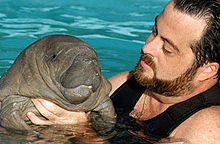 Antonio Mignucci, PhD 1996, a biological oceanographer specializing in the management and conservation of marine mammals
Antonio Mignucci, PhD 1996, a biological oceanographer specializing in the management and conservation of marine mammals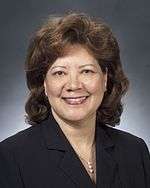
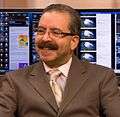 Orlando Figueroa, BS 1978, Director of the Mars Exploration Program in NASA
Orlando Figueroa, BS 1978, Director of the Mars Exploration Program in NASA William A. Navas, Jr., BS 1965, the first Puerto Rican to be named an Assistant Secretary of the Navy
William A. Navas, Jr., BS 1965, the first Puerto Rican to be named an Assistant Secretary of the Navy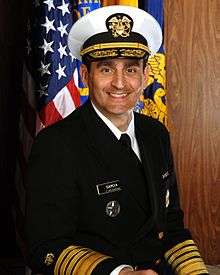 Joxel García, BS, former four-star admiral in the U.S. Public Health Service Commissioned Corps. He served as Assistant Secretary for Health and currently serves as the President of the Ponce School of Medicine
Joxel García, BS, former four-star admiral in the U.S. Public Health Service Commissioned Corps. He served as Assistant Secretary for Health and currently serves as the President of the Ponce School of Medicine- Emilio Díaz Colón, Adjutant General of the Puerto Rican National Guard and later the Superintendent of the Puerto Rican Police Force.
See also
- University of Puerto Rico strikes, 2010–2011
References
- "pag 1" (PDF). Retrieved 2011-02-28.
- "University of Puerto Rico at Mayaguez (UPRM) Final Self-Study Design" (PDF). uprm.edu. Retrieved 8 January 2016.
- Mónica Hechevarría (2008-02-24). "Huellas". El más viejo del RUM. Puerto Rico: El Nuevo Día. p. 58.
- Anton, George F. (1963). Since the beginning of time: the history of the College of Agriculture and Mechanic Arts, beginning with the originators of the idea and up to 1962. Office of Information, College of Agriculture and Mechanics Arts, University of Puerto Rico. p. 239.
- "El valor de saber renunciar" (in Spanish). Retrieved 2011-03-01.
- "El ex rector del RUM, Rafael Pietri Oms, liderará el movimiento político en el Oeste" (in Spanish). El Nuevo Dia. Associated Press. 13 May 2008. Retrieved 2010-06-23.
- "uprm.edu" (in Spanish). Archived from the original on 2010-06-09. Retrieved 2010-06-23.
- Vargas Saavedra, Maelo (14 March 2005). "Muere ex rector del RUM" (in Spanish). PRIMERA HORA. Retrieved 2010-06-23.
- "uprm.edu" (PDF) (in Spanish). Retrieved 2010-06-23.
- "uprm.edu" (in Spanish). Retrieved 2010-06-23.
- "Seeking solutions" (PDF). www.adastra-ks.org. Retrieved 2019-11-30.
- "Resolution" (PDF). academic.uprm.edu. Retrieved 2019-11-30.
- "universia" (in Spanish). Retrieved 2010-06-23.
- Vargas Saavedra (August 31, 2010). "Busca fumar pipa de la paz en el RUM". Primera Hora (in Spanish). Puerto Rico: Primera Hora. Retrieved August 31, 2010.
- Caquías (May 14, 2013). "Nombrados los Rectores Interinos". El Nuevo Día (in Spanish). Puerto Rico: El Nuevo Día. Retrieved May 18, 2013.
- "Nombran decimotercer rector del RUM". uprm.edu. Retrieved 8 January 2016.
- "pag 5" (PDF). Retrieved 2011-02-28.
- sus puertas el Café Bistro Hacienda Lealtad colegial
- "2_07ProfileFRONT_11-50.indd" (PDF). Retrieved 2010-08-13.
- "Civil Engineering and Surveying". Civil.uprm.edu. Retrieved 2010-08-13.
- "UPR Mayagüez Colegio de Ingeniería". Ing.uprm.edu. Retrieved 2010-08-13.
- Archived June 10, 2010, at the Wayback Machine
- "Electrical and Computer Engineering @ UPR Mayagüez". Ece.uprm.edu. Retrieved 2010-08-13.
- Archived November 22, 2008, at the Wayback Machine
- "Universidad de Puerto Rico". Upr.edu. Retrieved 2010-08-13.
- Rodriguez, Victor M. (2010-06-21). "Puerto Rico: The Invisible and Recurring Social Struggles in the Oldest Colony in the World". Dissident Voice. Retrieved 2010-08-13.
- "Schools". Hispanicengineer.com. Archived from the original on March 28, 2010. Retrieved 2010-08-13.
- "UPR Mayagüez : UPR Informa". 10x10.upr.edu. Archived from the original on 2011-07-20. Retrieved 2010-08-13.
- "UPRM" (PDF) (in Spanish). Retrieved 2008-01-16.
- Asociaciones Estudiantiles
- Colegial se extiende fuera del RUM
- SIEMPREVIVAS
- para el desarrollo de las comunidades

